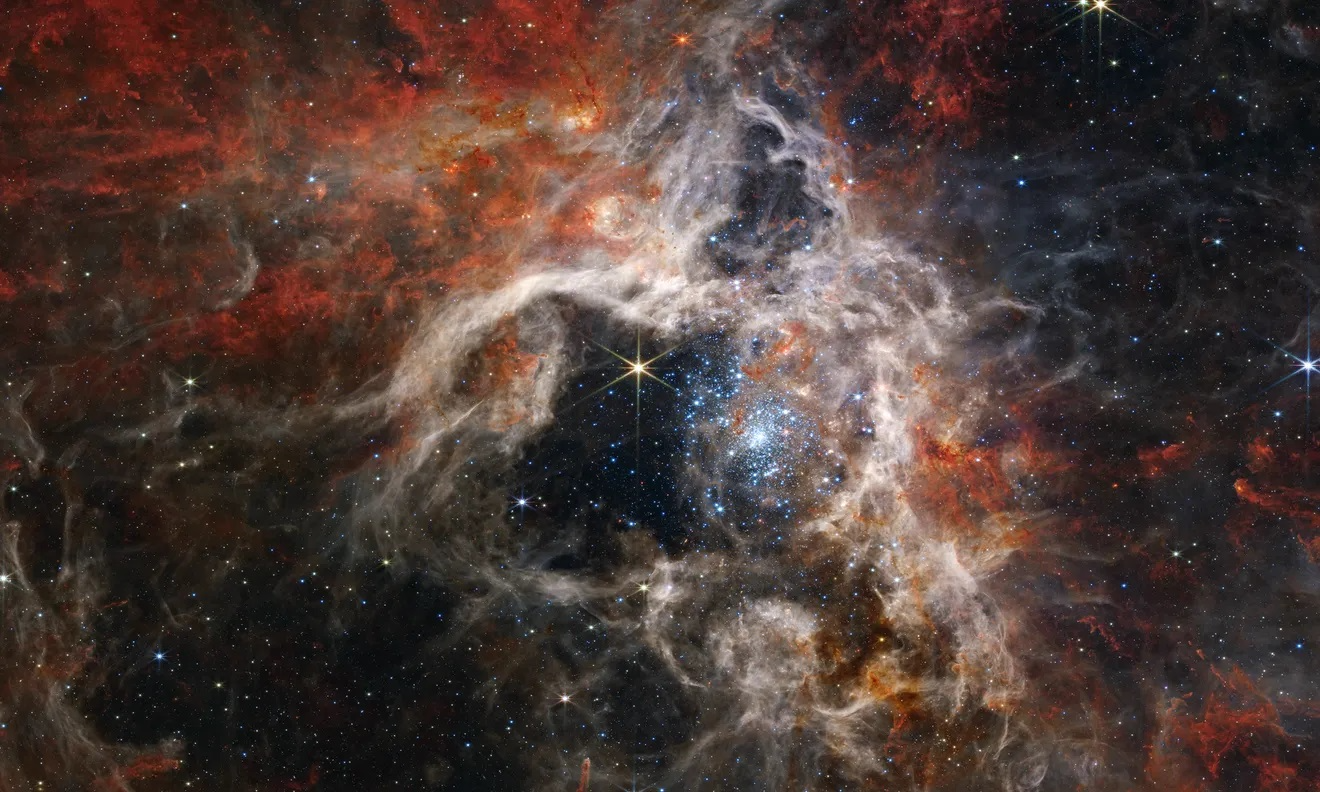Reviewed by Mila PereraSep 20 2022
Classical models of stellar development have paid little attention to the early history of stars. Thomas Steindl of the University of Innsbruck’s Department of Astro- and Particle Physics has shown for the first time that the early stage of stars affects their biography. The research was published in the journal Nature Communications.
 Tarantula Nebula: In this famous star-forming region in our neighboring galaxy, the Large Magellanic Cloud, many young stars are still in their molecular clouds, pictured by James Webb Space Telescope. Image Credit: University of Innsbruck
Tarantula Nebula: In this famous star-forming region in our neighboring galaxy, the Large Magellanic Cloud, many young stars are still in their molecular clouds, pictured by James Webb Space Telescope. Image Credit: University of Innsbruck
From babies to teenagers, stars in their “young years” pose a significant scientific challenge. In theoretical models, the star formation process is especially intricate and hard to map. Observing the oscillations of stars is one of the few techniques to learn more about their genesis, structure, or age.
Comparable to the exploration of the Earth's interior with the help of seismology, we can also make statements about their internal structure and thus also about the age of stars based on their oscillations.
Konstanze Zwintz, Institute for Astro- and Particle Physics, University of Innsbruck
The astronomer is considered a pioneer in the new area of asteroseismology. He directs the research group “Stellar Evolution and Asteroseismology” at the University of Innsbruck’s Institute for Astro- and Particle Physics.
In recent years, the study of stellar oscillations has evolved substantially due to the possibilities for accurate observation with the help of telescopes in space like Kepler, TESS, and James Webb. These advances are currently providing new insights into the old theories of stellar evolution.
With a New Model to Zero Hour of Adult Stars
Stars are referred to as “children” while their cores are not yet burning hydrogen to helium. They are in the pre-main sequence at this point. After ignition, they beocme adults and continue onto the main sequence.
Research on stars has so far focused mainly on adult stars—such as our Sun.
Thomas Steindl, Department of Astro- and Particle Physics, University of Innsbruck
Thomas Steindl, a member of Konstanze Zwintz’s research group says, “Even if it sounds counterintuitive at first glance, so far little attention has been paid to the evolution of the pre-main sequence because the phase is very turbulent and difficult to model. It's only the technological advances of recent years that allow us a closer look at the infancy of stars - and thus at that moment when the star begins to fuse hydrogen into helium.”
The two Innsbruck researchers have now presented a model that may be used to effectively describe the early stages of a star’s life long before they become adults in their current study. MESA (Modules for Experiments in Stellar Astrophysics), an open-source stellar evolution tool, serves as the foundation for the model.
Thomas Steindl spent months perfecting the strategy for using this stellar evolution algorithm to reproduce the chaotic phase of early star formation and then anticipate their oscillations after being inspired by a discussion by astronomer Eduard Vorobyov of the University of Vienna at a 2019 symposium.
“Our data show that stars on the pre-main sequence take a very chaotic course in their evolution. Despite its complexity, we can now use it in our new theoretical model,” Steindl added.
Thus, the astronomer demonstrates that the manner a star is produced influences its oscillation behavior even after nuclear fusion is ignited on the main sequence.
The infancy has an influence on the later pulsations of the star: This sounds very simple, but it was strongly in doubt. The classical theory assumes that the time before ignition is simply irrelevant. This is not true: Comparable to a musical instrument, even subtle differences in the composition lead to significant changes in the tone. Thus, our modern models better describe the oscillations in real stars.
Thomas Steindl, Department of Astro- and Particle Physics, University of Innsbruck
Konstanze Zwintz is thrilled about this discovery and optimistic about the future.
Konstanze Zwintz concludes, “I was already convinced about 20 years ago, when I first saw the oscillation of a young star in front of me on the screen, that I would one day be able to prove the significance of early stellar evolution on the 'adult' star."
He continued, "Thanks to the great work of Thomas Steindl, we have now succeeded: Definitely a eureka moment for our research group and another milestone for a better understanding of the growth steps of stars.”
Journal Reference
Steindl, T., et al. (2022) The imprint of star formation on stellar pulsations. Nature Communications. doi.org/10.1038/s41467-022-32882-0.